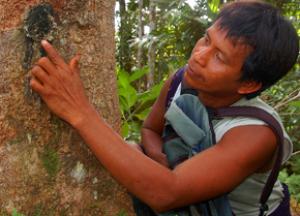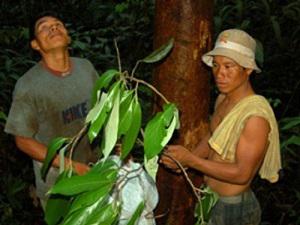Social media video featuring the project.
Mishquipanga (Renealmina alpina) - a dye plant from the Peruvian Amazon
30 Aug 2011 Brillo Nuevo, Peru, Central and Latin America Forests
Sustainable Harvest and Marketing of Non-Timber Forest Products (NTPFs) with Indigenous Communities in the Northern Peruvian Amazon I
Sustainable Harvest and Marketing of Non-Timber Forest Products (NTPFs) with Indigenous Communities in the Northern Peruvian Amazon III
This project promotes the sustainable harvest and sale of non-timber forest products (NTFPs) such as essential oils and innovative handicrafts by native communities in the northern Peruvian Amazon.

This project will catalyse forest conservation in the 433,000 hectare Ampiyacu-Apayacu Regional Conservation Area in the northern Peruvian Amazon by empowering native communities to sustainably harvest and market value-added non-timber forest products including essential oils and innovative fair-trade handicrafts as an alternative to destructive logging and cash-crop agriculture. The project will expand from its pilot project work in the Bora village of Brillo Nuevo to three new villages that include Huitoto, Ocaina, and Yagua natives.

Specific objectives are:
1) Promote the sustainable harvest of wild plants used for making value-added products.
We will work with native woodmen to assess the abundance, sustainable harvest and economic potential of key non-timber forest products by combining traditional knowledge, curiosity, and locally adapted scientific and processing skills. We will survey high forest sites to map the location and harvest potential of copal, “moena,” and other aromatic trees. The team will begin monitoring the recovery of resin lumps on copal trees harvested in the past two years. These data will be used to devise a local copal management plan and help establish guidelines for other resin-harvesting enterprises in the region.
The project will also work with communities to sustainably harvest chambira palm trees and other plants used in making handicrafts. We will survey palm trees in fallow farm fields with artisans, promote careful palm-stem harvesting and support enhanced planting of palms and dye plants in backyard gardens, farm fields and forest sites.
2) Produce essential oils from aromatic plants.
The project team will distil resin lumps from copal trees, leaves and other parts from other aromatic plants to measure the yield and quality of essential oil from diverse species. Fragrance and essential oil specialists will evaluate samples for commercial potential.
3) Promote the creation and marketing of high-quality handicrafts.
The project team will work with native artisans to refine designs for crafts developed in the project’s first year that include belts, guitar straps, net shopping bags, and trivets and create new types of crafts including dog collars and leashes, jewellery, holiday tree ornaments, and cell-phone holders for test marketing. We will encourage artisan cooperation to promote skill sharing, quality control, marketing and long-term supply for plants used in making crafts and gather information, images, and videos of artisans and communities to build public connections to the people, places and plants linked to these crafts and explain how buying them supports forest conservation and community wellbeing.
Social media video featuring the project.
Mishquipanga (Renealmina alpina) - a dye plant from the Peruvian Amazon